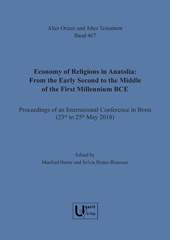2019 - ISD
E-book
Digital Version
Download | Copy/paste | Printing
Economy of Religions in Anatolia and Northern Syria : From the Early Second to the Middle of the First Millennium BCE
205 p.
- "Religions" are always costly - one has to give offerings (with material value) to the gods, one has to provide the salary for religious specialists who offer their service for their clients, one has to arrange festivals and liturgies - and of course, one has to provide the material means for building temples or shrines. But these costs also repay - as the gods give health or well-being as reward for the offerings. Even if one can never be absolutely certain about such a reward, one at least might earn social reputation because of one's (financial) involvement in religion. But temples are also economic centres - "employing" (often in close relation to the palace) people as workers, craftsmen or "intellectuals" in different positions whose "costs of living" are supplied by the temple. Individual religious specialists receive payment for their service to cover their own costs of living. Although this might sound "modern", religion and economy were intertwined with each other in ancient society also. For this re
- ason, the papers of this conference volume analyse and discuss how the cults, rituals and institutions in Anatolia in the 2nd and 1st millennium contribute to the economic process in those areas. [Publisher's text].
- Special access authorizations may apply; please contact us for further information.
-
Information
ISBN: 9783868353150
DISCIPLINES


